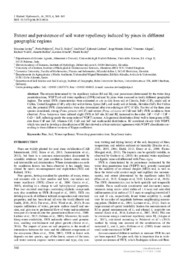Por favor, use este identificador para citar o enlazar este ítem:
https://hdl.handle.net/11000/5254Registro completo de metadatos
| Campo DC | Valor | Lengua/Idioma |
|---|---|---|
| dc.contributor.author | Iovino, Massimo | - |
| dc.contributor.author | Pekárová, Pavla | - |
| dc.contributor.author | Hallett, Paul D. | - |
| dc.contributor.author | Pekár, Ján | - |
| dc.contributor.author | Lichner, Ľubomír | - |
| dc.contributor.author | Mataix Solera, Jorge | - |
| dc.contributor.author | Alagna, Vincenzo | - |
| dc.contributor.author | Walsh, Richard | - |
| dc.contributor.author | Raffan, Annette | - |
| dc.contributor.author | Schacht, Karsten | - |
| dc.contributor.author | Rodný, Marek | - |
| dc.contributor.other | Departamentos de la UMH::Agroquímica y Medio Ambiente | es |
| dc.date.accessioned | 2019-09-03T10:43:45Z | - |
| dc.date.available | 2019-09-03T10:43:45Z | - |
| dc.date.created | 2018-10-29 | - |
| dc.date.issued | 2019-09-03 | - |
| dc.identifier.issn | 1338-4333 | - |
| dc.identifier.uri | http://hdl.handle.net/11000/5254 | - |
| dc.description.abstract | The extent (determined by the repellency indices RI and RIc) and persistence (determined by the water drop penetration time, WDPT) of soil water repellency (SWR) induced by pines were assessed in vastly different geographic regions. The actual SWR characteristics were estimated in situ in clay loam soil at Ciavolo, Italy (CiF), sandy soil at Culbin, United Kingdom (CuF), silty clay soil at Javea, Spain (JaF), and sandy soil at Sekule, Slovakia (SeF). For Culbin soil, the potential SWR characteristics were also determined after oven-drying at 60°C (CuD). For two of the three pine species considered, strong (Pinus pinaster at CiF) and severe (Pinus sylvestris at CuD and SeF) SWR conditions were observed. Pinus halepensis trees induced slight SWR at JaF site. RI and RIc increased in the order: JaF < CuF < CiF < CuD < SeF, reflecting nearly the same order of WDPT increase. A lognormal distribution fitted well to histograms of RIc data from CuF and JaF, whereas CiF, CuD and SeF had multimodal distributions. RI correlated closely with WDPT, which was used to develop a classification of RI that showed a robust statistical agreement with WDPT classification according to three different versions of Kappa coefficient | es |
| dc.description.sponsorship | This work was supported by the Slovak Scientific Grant Agency VEGA Project Nos. 2/0054/14 and 2/0009/2015 | - |
| dc.description.sponsorship | the Slovak Research and Development Agency Project No. APVV-15-0160, | - |
| dc.description.sponsorship | and it results from the project implementation of the “Centre of excellence for integrated flood protection of land” (ITMS 26240120004) | - |
| dc.format | application/pdf | es |
| dc.format.extent | 9 | es |
| dc.language.iso | eng | es |
| dc.rights | info:eu-repo/semantics/openAccess | es |
| dc.subject | Pine | es |
| dc.subject | Soil | es |
| dc.subject | Water repellency | es |
| dc.subject | Water drop penetration time | es |
| dc.subject | Repellency index | es |
| dc.subject.other | 631 - Agricultura. Agronomía. Maquinaria agrícola. Suelos. Edafología agrícola | es |
| dc.title | Extent and persistence of soil water repellency induced by pines in different geographic regions | es |
| dc.type | info:eu-repo/semantics/article | es |
| dc.identifier.doi | 10.2478/johh-2018-0024 | - |
| dc.relation.publisherversion | http://dx.doi.org/10.2478/johh-2018-0024 | - |

Ver/Abrir:
3-Iovino et al. JHH 2018.pdf
832,43 kB
Adobe PDF
Compartir:
 La licencia se describe como: Atribución-NonComercial-NoDerivada 4.0 Internacional.
La licencia se describe como: Atribución-NonComercial-NoDerivada 4.0 Internacional.
.png)